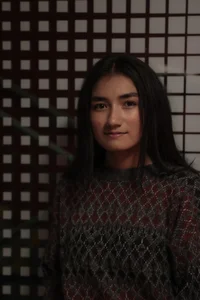
Tucked into a corner of the Belkin Gallery is a foam island littered with gray cushions, positioned in front of a large screen. Sitting on the soft surface makes me feel slightly unstable, as if I am actually caught in the rolling waves that are being projected in front of me. In another room, people perch on heated boulders, feeling themselves melt into the earth as they watch a clip of thick lava cascading down jagged rocks. For the first time during a hectic week of final exam prep, I finally feel at peace.
The Belkin’s Elemental Cinema exhibit features three films by filmmaker Arjuna Neuman and UBC philosophy professor Denise Ferreira da Silva: Serpent Rain (2016), 4 Waters – Deep Implicancy (2019) and Soot Breath // Corpus Infinitum (2020).
Within each film, there is a lot to unpack. Endless montages of luscious forests and vast oceans, accompanied by poetic but often vague captions that make it difficult to understand from just one viewing. However, as curator Melanie O’Brian put it: “Art is propositional and doesn't necessarily need to deliver answers, but can open a door to a different way of thinking.”
Slowly but surely, she is proven right – as I sit through each film for a second viewing, I begin to piece together patterns. This was part of Ferreira da Silva and Neuman’s goal: to interrupt the viewer’s expectations of time and pacing, as well as “disrupt our understanding of the way that we see our world through Western rational knowledge.”
It is a commentary on “violence against other people [and] violence against the world” with a specific focus on the climate crisis.
“The further we get away from our environment and being informed by our environment, the more we enable this abstraction which enables violence,” explained O’Brian. “This is a question of capitalism. It's a question of colonization, slavery and extractive practices.”
In the process of making the films, Neuman relied on what he calls a “mixtape aesthetic.” As he forms connections between elements of the film, he relies on sensory experiences rather than intellectual reasonings. Each film has a specific playlist that has been carefully curated to fully immerse viewers in its universe.
During my visit, however, the UBC Contemporary Players take control of the soundtrack. Each semester, they spend time learning about the exhibit, then stage a concert in the gallery. The ensemble, led by director Paolo Bortolussi, makes an effort to play works by both up-and-coming composition students and established artists.
The musicians have striking chemistry between them. During Violent Water, a piece by UBC composition student Rajat Chowdury, the saxophonist subtly turns towards the clarinetist, passing on a motif that is then continued down the line, as each member of the quartet acknowledges the next.
Annis Lee (violin) and Alexander Beggs (viola) use quick, light bow strokes that stay true to their piece’s title, Seven Duos for Birds or Strings, by Canadian composer Emily Doolittle. It is an unconventional performance; they tap their strings with wooden pencils, the resulting percussive effect reminiscent of a bird’s beak knocking on tree bark.
Elemental Cinema will close on December 11, but O’Brian is excited for people to experience The Willful Plot, a new exhibition opening on January 12 which explores the garden as a site of resistance.
An earlier version of this article used the incorrect pronouns for Arjuna Neuman. The Ubyssey regrets this error and the article was corrected on December 9 at 3:05 p.m.


